| My pages about Iceland |

September 2020: Who would have thought this would be possible, that we would travel abroad autumn 2020! But we did! We found an opportunity at the very VERY last minute to travel to Iceland! It meant 1 week in quarantine in a nice little house in middle of nowhere, but with great views! And 2 weeks of travelling around the whole island. And being able to travel here during the Covid time has been such a unique opportunity, with hardly anyone around and being able to experience the amazing nature without disturbances. In short: it was a fantastic trip!
And during our travels through the northern parts of Iceland we dropped by Glaumbaer, a lovely historical little place and absolutely worth the stop on our way.
All the photos in the collage below are clickable, so you can view the larger photo.
Glaumbær, the turf farmhouse
Iceland
Some call Iceland the land of fire and ice. But I also would like to call it the land of the many rainbows! I think we have seen at least one rainbow on each and every day of our stay. And todays beautiful rainbow was right here, over the turf farmhouse at Glaumbaer.
Visiting Glaumbaer is like a warp back in time; here you can see a fine example of how large farmhouses historically were build in Iceland. With its turf walls and turf roof, it melts perfectly in the surrounding landscape of green coloured pastures and the dark imposing mountains in the far distance. For centuries turf was the main building material in Iceland, an architectural tradition that was brought to Iceland by the Vikings more than a thousand years ago.
But before I continue, please let me give you an idea where you can find Glaumbaer on the map. It is located about 300 kilometers / 3:45 hours drive north of Reykjavik.
But if you are driving through the northern parts of Iceland, than it is most likely only a short detour from your route, as it is located just off the main Road 1 (also called the Ring Road, and in Icelandic: Þjóðvegur 1 or Hringvegur). At the village of Varmahlíð take a turn left (when driving from Reykjavik) onto road 75. From here it is only a 10 minutes drive on a good road (8 kilometers) to reach Glaumbaer. If you see the little church with the red roof on your right hand side, you have arrived.
location on the map: 65° 36,675'N, 19° 30,285'W
But we actually drove from the other direction, from the north, pasing the town of Siglufjörður during the morning. An absolute beautiful coastal drive! Curvy, very narrow, steep cliffs, partly on gravel, crazy scary, but with gorgeous views over the mountain landscape and the ocean. And this was also my first ever time driving through a one-lane tunnel... oh yes, a few kilometers long tunnel, with only ONE lane, lots of curves and impossible to see if a car would come from the other direction. But I survived ;-)
And the weather today is passionate to say the least!! It is even more passionate than it has been so far during our Iceland trip. After each and every curve in the road the weather seemed to change, treating us on horizontal rain, to storm-like winds, periods of 'warm' sunshine, quickly changing to a drizzle or some boring plain grey clouds.
In the photo above you can see one of the many skies we experienced during todays road trip towards Glaumbaer.
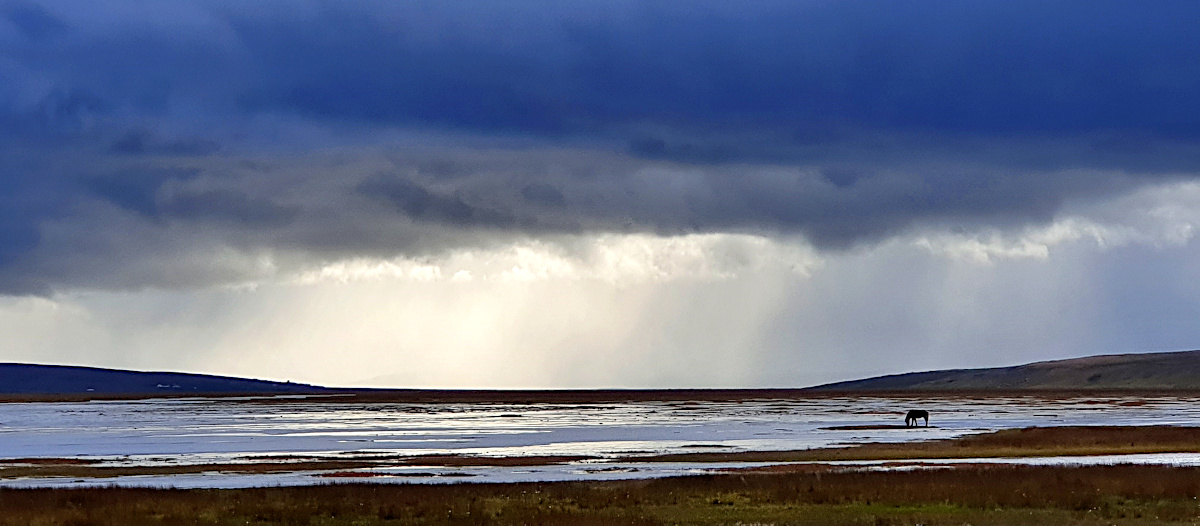
Lonely horse in a vast open landscape under a moody sky.
The moment in the photo above was really magical! We were driving down a hill and saw 3 horses out in the vast landscape, and it almost looked like they were standing in water. It looked so eery and magical at the same time!! But, it was impossible to stop the car here (as it often is on Icelandic roads). But luckily, almost down the hill, we saw a spot to stop the car and hop out to take some photos.... just before it started to rain again.
The sky was evil dark blue and it had been raining for quite some time, so I was absolutely convinced that we would visit Glaumbaer in the pouring rain. But suddenly the clouds gave way for some clear sky and the sun surprisingly broke through. And the good part was that we were only a few minutes away from Glaumbaer!
Åke hardly managed to stop the car at Glaumbaer before I jumped out of it. I wanted to have at least one photo before the rain would come down again. I quickly jogged up a little hill in front of Glaumbaer where I took this first shot of the green turf-roofs of the farm with the dark blue sky hugging it from all sides. The magic light of the moment turned the field and the roof in a vibrant unreal green colour. And I sighed happily, put down my camera, and took a few moments to take in the rough beauty of this historical building, being in full harmony with its surroundings.
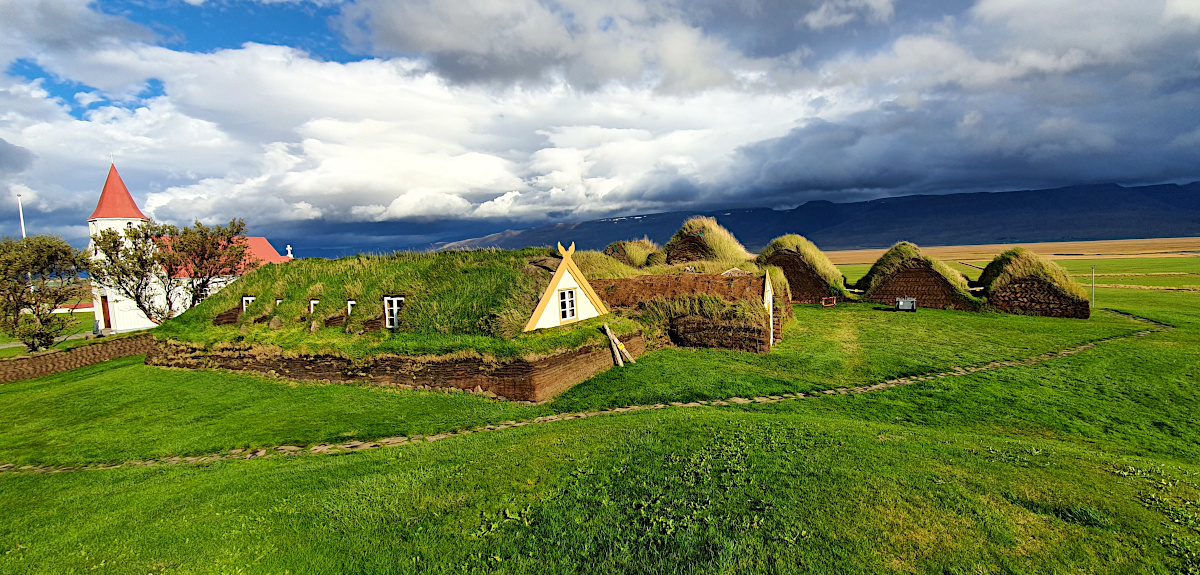
The photo above gives a relative good overview of the farmhouse, with the red-roofed Glaumbaer church to the left. There has stood a farmhouse in this very spot since the settlement of Iceland, around the 9th Century, when Norse settlers migrated across the North Atlantic to Iceland.
I guess most of us are used to see historical building made out of timber. But when you drive around Iceland, you soon start to realize that timber is a rare resource, as there are hardly any trees or forest to be seen on the island. And due to this scarce opportunity to get timber for building, Icelanders used turf constructions to build their homes instead. And these thick natural walls of turf are a good isolation and usually last around a generation before it needs to be replaced. For the interior frame and all the paneling they used imported timber, but also driftwood.
But neither could Icelanders build stone buildings. The reason was that no lime deposits had been found, meaning it was not possible to make mortar. This left turf as the only easily available domestic building material for houses.
Glaumbaer turf farm consists of 13 buildings. It is now a museum, and gives a glimpse of how Icelandic people used to live during times when there was limited access to the outside world and to supplies.
Turf is the oldest and most common material that historically was used in Icelandic buildings for 1100 years. A tradition that has now almost disappeared however, but still can be seen in some places, like here in Glaumbaer. The most common way that the Icelandic turf houses were build was by laying a large foundation made of flat stones. On top of that a wooden frame would be built to hold the load of turf. Blocks of turf would than be fitted around the wooden frame to become the isolated walls of the building. Often a second layer would be added, and laid for example, like in the photo left above, in a beautiful herringbone pattern.
Finally the roof is covered with turf as well. Decorative are the gables that are made of timber; although not all buildings have these lovely gables. At Glaumbaer the cream coloured gables, with the warm yellow trimmings and doors looked colourful and bright against the turf and grass walls and roof, and made for a perfect contrast and cheerful look.
"Gilsstofa" (the house from Gil)
Besides the turf farmhouse you can also see 2 timber houses from the 19th century. The one in the photo above is called "Gilsstofa" (the house from Gil). This turf-roofed house dates back to 1849. It was quite usually to place these type of timber houses next to turf farmhouses.
The history of this particular house is quite interesting: it was originally built in Espihóll in Eyjafjörður. But when the owner of the house moved, he took the house with him. That is quite a project if you would do that nowadays, but at that time, and considering the harsh Islandic climate, it is hard for me to grasp the enormous task to do that.
In the first part of the journey the house was transported over ice; pulled by horses. Than it was loaded on a ship and transported further, and the final leg of the journey the timber was towed to a place called Hjaltastaðir. But this was not the only journey of the house. In total the house was moved no less than SIX times! Gilsstofa was reconstructed at the Glaumbær museum in 1996-97.
Gilsstofa now houses the information centre and a museum store.
I already mentioned that a farmhouse is said to have stood on the hill at Glaumbær since the settlement of Iceland, around the 9th Century. The building that you see here are not that old though. The present building vary a bit in age, with the most recent addition dating back to 1879. The oldest parts, amongst others the kitchen, date back to the mid 18th century. The current form of the farmhouse is similar to that of many large farmhouses in Skagafjördur from the 18th and 19th centuries.
I found it quite interesting to learn that the farmhouse at Glaumbaer has remained unchanged between 1879 and 1939. And even more interesting that people lived on this farm until 1947! That doesn't sound 'that' long ago after all. After the last inhabitants moved out of the turf farm in 1947 the house was declared a conserved site.
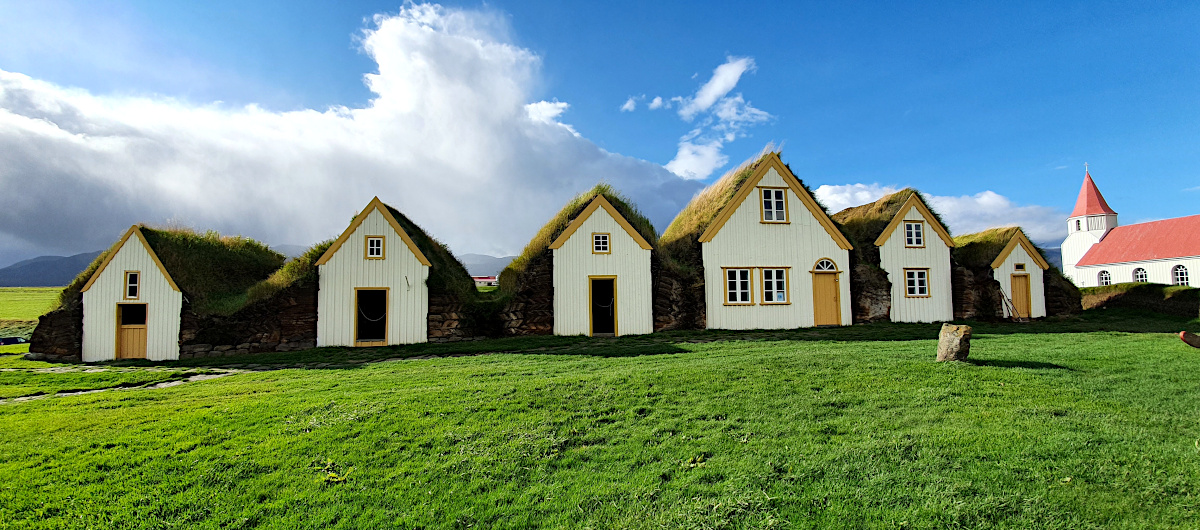
Six of the houses face the yard to the east, forming a gabled farmhouse. And together they form a beautiful sight! I visited during the afternoon and these gables were in the shade. However, they still do make for a very nice photo, even in the shade. A visit during the morning would probably give you an opportunity to take a photo of these picturesque gables with some nice sunlight on them.
To the left on the photo is a smithy, and beside it two storage houses, living rooms on each side of the entrance and firewood storage to the right. And in the photo above you can also see that the door is open on the 3 houses to the left. These give you an opportunity to take a peak inside, which you can see in the photos below. And Åke even managed to take a photo through one of the windows, so you can see a tiny bit of the interior.
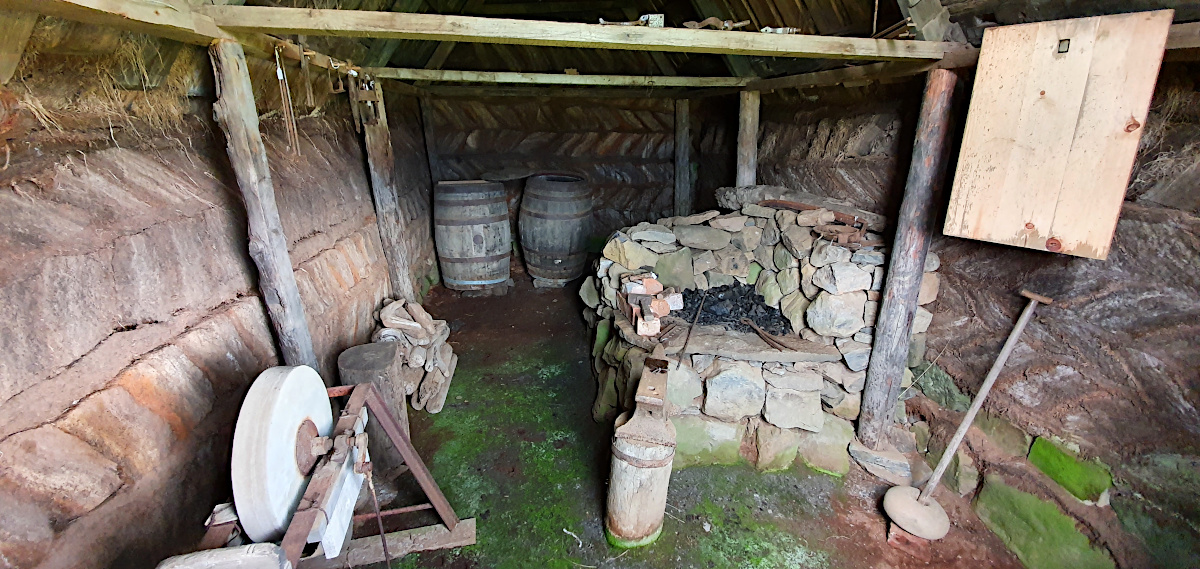
The smithy
looking inside one of the storage houses
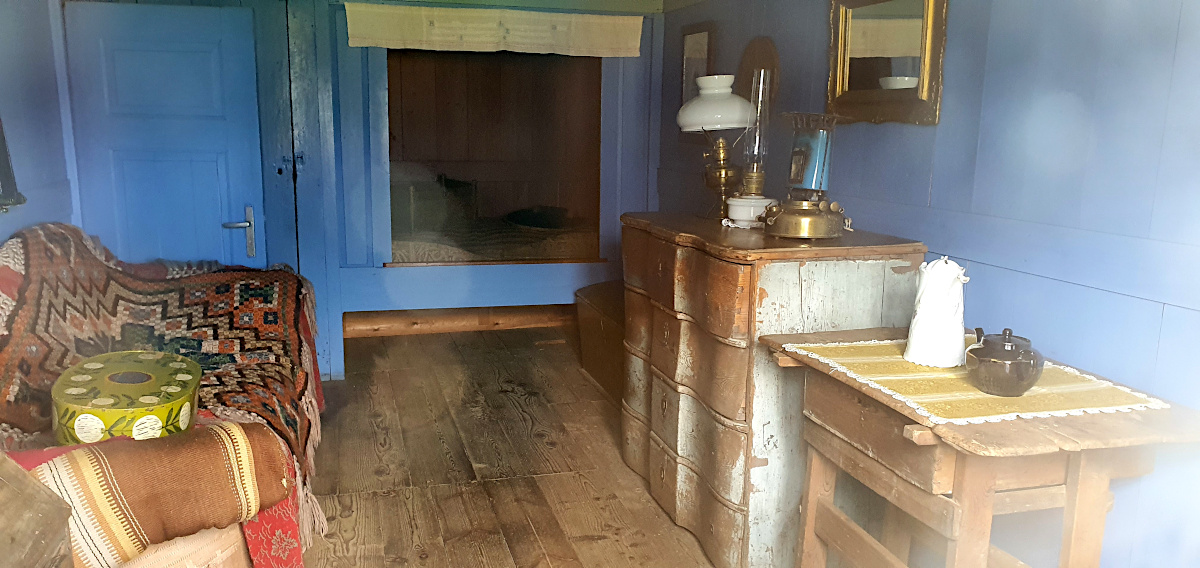
Taking a peak inside through one of the windows
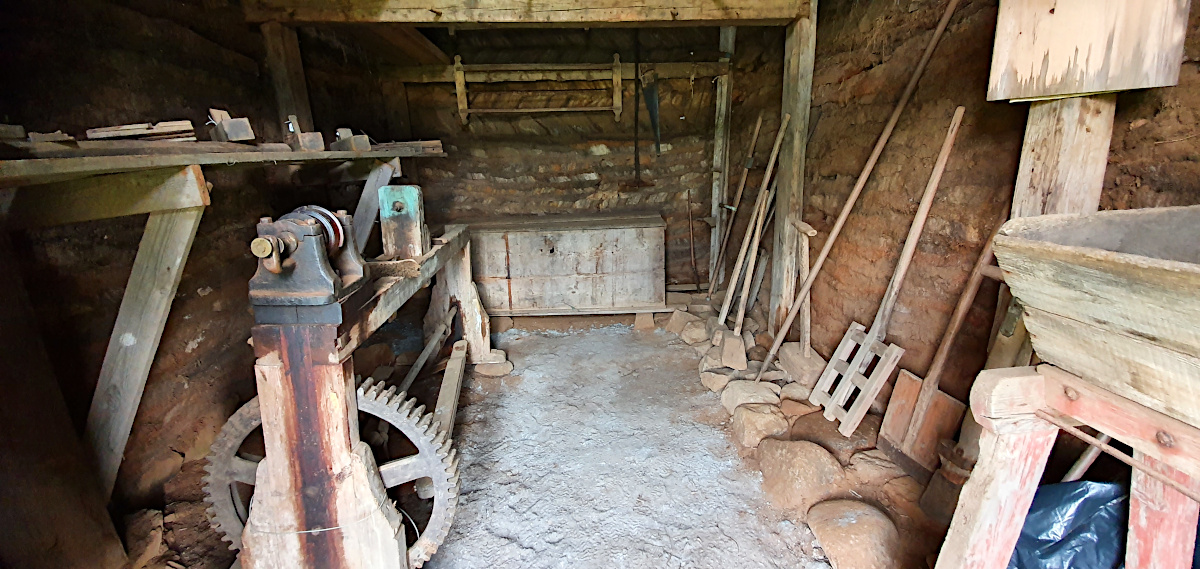
looking inside one of the storage houses
Due to the Covid epidemic we decided not to visit the museum on the inside, which was a pitty really, as I think this might have been quite interesting. In total there are 13 buildings that make up the Glaumbaer farm. And what you cannot see from the outside is that all these buildings are connected by internal passages. And these connecting passages to the individual units have remained unchanged for many centuries. The main reason for this way of building is to keep as much as possible of the warmth inside the buildings. And the reason for the many small building is that this makes replacing the turf much easier, because it is much easier and practical to rebuild one small building at a time, than to rebuild a big building in one go.
When you take a quick peak over the turf wall, you can see the red-roofed church, dating back to 1926. Like all churches we dropped by, the doors were closed, so we couldn't take a look inside.
In front of the church you can see a statue of Guðríður (by Ásmundur Sveinsson). She is most likely the first European woman to give birth on North American soil. She gave birth to a son, Snorri Þorfinnsson, in about 1004 while on exploration long before Columbus discovered America. And Snorri Þorfinnsson has lived on this very farm. Guðríður, is considered Iceland’s most-travelled woman of the Middle Ages.
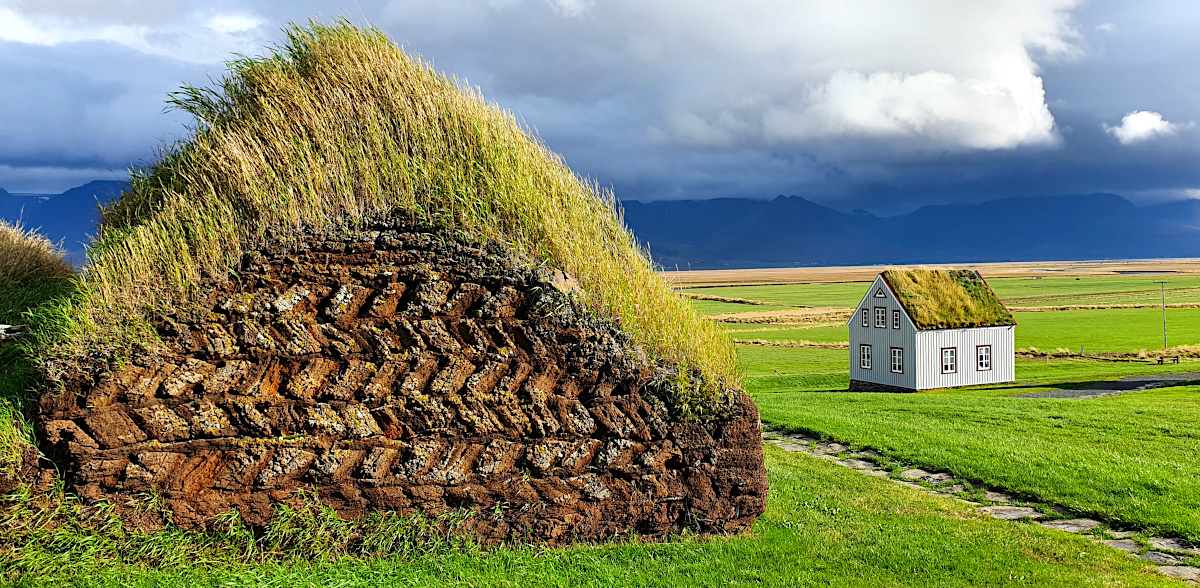
Peat wall, Glaumbær
The turf house tradition of Iceland is not on the UNESCO World Heritage list, but it is on the UNESCO tentative list. And Glaumbaer is mentioned in this tentative list, together with around 13 others, of which I have visited the Hofskirkja, Víðimýrarkirkja and Keldur.
It is time to return to the car and continue our trip. But as we slowly strole back to our car it starts to rain again. And quite a bit as well! So we start running, trying to escape as much of the raindrops as we can....
But suddenly, when I turn aroun the corner, there it is again: the typical Icelandic rainbow! And despite the rain dropping down on my head and making me soaking wet, I just had to take a photo. And one more, and one more..... Ah, it is always difficult to leave a beautiful place, especially when it treats you on a beautiful rainbow to boost.
Simone & Åke, September 2020, Glaumbær, Iceland

It would be great to hear from you!
You can reach me by sending me an Email.
Or leave a comment / reaction in the box below.
You can also follow me on Facebook: Sim1 around the World Blog
:-) Simone